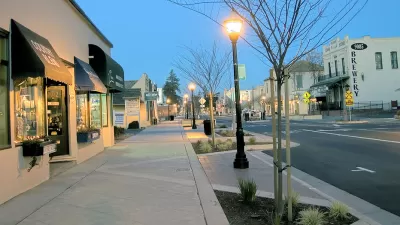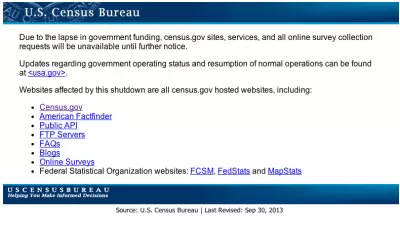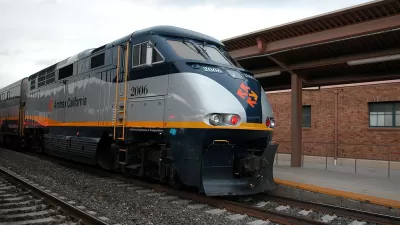United States

The Next Big Thing: "Sit-able Cities"
Supported by imagery of human urban conduct, Chuck Wolfe argues that walkable is good, but sit-able is better—and that "it’s time for the next big focal point and the next big idea, the 'Sit-able City'."

One of the Nation's Fastest Growing Cities Wants to Gobble Up 8,000 More Acres
After waiting more than five years, Elk Grove, one of the fastest growing cities in California and the country, will soon learn whether it can expand its planning area by another 8,000 acres to accommodate more residents.

Roundabouts Win Again, This Time on "MythBusters"
“MythBusters” has put another urban debate to bed. According to a recent episode of the Discovery Channel show, roundabouts really are more efficient than four-way stops.
"Car-Free" Families on the Rise
Micheline Maynard writes about an AASHTO study showing that the share of American families who don't own cars had been declining since 1960 but stopped in 2007 at 8.7%. By 2011, it had budged up to 9.3%. She suggests four reasons for the reversal.
Place-Based Federal Initiative Offers Promise for Reducing Poverty
With urban inequality getting increased attention from politicians and pundits, many have wondered whether cities actually have the tools to address this growing challenge. A new federal initiative offers a promising solution.
Federal Dysfunction Imperils Improving City Finances
A new report from the National League of Cities shows municipal revenues climbing across the U.S. in the aftermath of the worst economic crisis in decades. But pension and health costs, and federal budget issues, are causing concern.
Where Can America's Middle Class Afford to Live?
Though owning a home may be easier today than during the housing bubble due to lower interest rates and prices, in many cities across the U.S. the middle class is widely excluded from homeownership. Trulia crunches the numbers.
Urban-Rural Rift in Colorado Results in Secession Vote
Come November, 11 of Colorado's 64 counties, mostly in northeast, will vote to form a new state. Jack Healy explores what's behind the 51st State Initiative, what set it off, as well as other secession movements, mostly by rural areas in the U.S.

Where to Find Federal Data During the Shutdown
When the federal government shut down last week it took many agency websites along with it, depriving planners around the U.S. of resources they use daily. The blog Data Insights has put together a list of alternative sources for federal data.

Will Amtrak Regional Service End in California, Illinois and Indiana?
Unless these states come to an agreement with Amtrak by Oct. 16 to help subsidize regional rail service, required by the Passenger Rail Investment & Improvement Act of 2008, Amtrak will cease operating them. Agreements were reached with 16 states.
How Can We Hype Downtown's Resurgence If We Can't Define It?
The U.S. Census Bureau uses a relatively crude definition of downtowns, complicating comparison between metros and opening up their findings to criticism. A new method of measuring downtowns via heat maps of job density aims to address this problem.
Why Walkability is a Civil Rights Issue
The NAACP is probably not the first advocacy group you think of when it comes to supporting walking and biking. But the civil rights organization encourages increasing physical activity in minority communities to help reduce childhood obesity.
These Cartoons About Car Culture Are No Joke
Andy Singer is an alternative transportation advocate that uses cartoons, rather than written diatribes or combative slideshows, to argue against America's auto-oriented environments and policies.
APA Celebrates America's Great Places
To celebrate National Community Planning Month, the American Planning Association (APA) has revealed its seventh annual list of the country's 10 great neighborhoods, 10 great streets, and 10 great public spaces.
The United (Watershed) States of America
What if the great adventurer and geographer John Wesley Powell had his way: That as the western states were brought into the union their shape would be dictated by watershed rather than political boundary? This blog - and map - depict this scenario.
Prius Founder Questions Future of Electric Vehicles
Toyota Motor Corp. Chairman Takeshi Uchiyamada, who helped develop the world's most popular hybrid-electric vehicle, questioned the ability of pure electric vehicles to supplant petroleum-fueled vehicles because of battery and charging challenges.
Designing the Indestructible Home
With extreme weather on the rise across the United States, a recent competition asked architects to design the resilient home of the future. The winners offer an impressive "balance between resiliency and livability," writes Emily Badger.
Urban Forestry Gets State-of-the-Art Assistance with LiDAR Technology
Advanced remote sensing technologies are providing cities and planners across the United States with new tools to assess urban tree canopy and develop more effective urban reforestation efforts.
Population Growth and Prosperity Don't Go Hand in Hand
If your city isn't attracting hordes of new residents does that mean it's not growing economically? Richard Florida and his colleagues seek to undermine those who equate population growth with economic health.
A Modest Proposal for Improving Federal Housing Aid
Although the Section 8 Housing Choice Voucher is one of the federal government's most effective housing programs, its administration by local public housing agencies limit its ability to de-concentrate poverty. A new report proposes a solution.
Pagination
Urban Design for Planners 1: Software Tools
This six-course series explores essential urban design concepts using open source software and equips planners with the tools they need to participate fully in the urban design process.
Planning for Universal Design
Learn the tools for implementing Universal Design in planning regulations.
planning NEXT
Appalachian Highlands Housing Partners
Mpact (founded as Rail~Volution)
City of Camden Redevelopment Agency
City of Astoria
City of Portland
City of Laramie


































